Qingyong Hu
Period-LLM: Extending the Periodic Capability of Multimodal Large Language Model
May 30, 2025Abstract:Periodic or quasi-periodic phenomena reveal intrinsic characteristics in various natural processes, such as weather patterns, movement behaviors, traffic flows, and biological signals. Given that these phenomena span multiple modalities, the capabilities of Multimodal Large Language Models (MLLMs) offer promising potential to effectively capture and understand their complex nature. However, current MLLMs struggle with periodic tasks due to limitations in: 1) lack of temporal modelling and 2) conflict between short and long periods. This paper introduces Period-LLM, a multimodal large language model designed to enhance the performance of periodic tasks across various modalities, and constructs a benchmark of various difficulty for evaluating the cross-modal periodic capabilities of large models. Specially, We adopt an "Easy to Hard Generalization" paradigm, starting with relatively simple text-based tasks and progressing to more complex visual and multimodal tasks, ensuring that the model gradually builds robust periodic reasoning capabilities. Additionally, we propose a "Resisting Logical Oblivion" optimization strategy to maintain periodic reasoning abilities during semantic alignment. Extensive experiments demonstrate the superiority of the proposed Period-LLM over existing MLLMs in periodic tasks. The code is available at https://github.com/keke-nice/Period-LLM.
Sage Deer: A Super-Aligned Driving Generalist Is Your Copilot
May 15, 2025Abstract:The intelligent driving cockpit, an important part of intelligent driving, needs to match different users' comfort, interaction, and safety needs. This paper aims to build a Super-Aligned and GEneralist DRiving agent, SAGE DeeR. Sage Deer achieves three highlights: (1) Super alignment: It achieves different reactions according to different people's preferences and biases. (2) Generalist: It can understand the multi-view and multi-mode inputs to reason the user's physiological indicators, facial emotions, hand movements, body movements, driving scenarios, and behavioral decisions. (3) Self-Eliciting: It can elicit implicit thought chains in the language space to further increase generalist and super-aligned abilities. Besides, we collected multiple data sets and built a large-scale benchmark. This benchmark measures the deer's perceptual decision-making ability and the super alignment's accuracy.
Lighten CARAFE: Dynamic Lightweight Upsampling with Guided Reassemble Kernels
Oct 29, 2024Abstract:As a fundamental operation in modern machine vision models, feature upsampling has been widely used and investigated in the literatures. An ideal upsampling operation should be lightweight, with low computational complexity. That is, it can not only improve the overall performance but also not affect the model complexity. Content-aware Reassembly of Features (CARAFE) is a well-designed learnable operation to achieve feature upsampling. Albeit encouraging performance achieved, this method requires generating large-scale kernels, which brings a mass of extra redundant parameters, and inherently has limited scalability. To this end, we propose a lightweight upsampling operation, termed Dynamic Lightweight Upsampling (DLU) in this paper. In particular, it first constructs a small-scale source kernel space, and then samples the large-scale kernels from the kernel space by introducing learnable guidance offsets, hence avoiding introducing a large collection of trainable parameters in upsampling. Experiments on several mainstream vision tasks show that our DLU achieves comparable and even better performance to the original CARAFE, but with much lower complexity, e.g., DLU requires 91% fewer parameters and at least 63% fewer FLOPs (Floating Point Operations) than CARAFE in the case of 16x upsampling, but outperforms the CARAFE by 0.3% mAP in object detection. Code is available at https://github.com/Fu0511/Dynamic-Lightweight-Upsampling.
Divide and Conquer: Improving Multi-Camera 3D Perception with 2D Semantic-Depth Priors and Input-Dependent Queries
Aug 13, 2024Abstract:3D perception tasks, such as 3D object detection and Bird's-Eye-View (BEV) segmentation using multi-camera images, have drawn significant attention recently. Despite the fact that accurately estimating both semantic and 3D scene layouts are crucial for this task, existing techniques often neglect the synergistic effects of semantic and depth cues, leading to the occurrence of classification and position estimation errors. Additionally, the input-independent nature of initial queries also limits the learning capacity of Transformer-based models. To tackle these challenges, we propose an input-aware Transformer framework that leverages Semantics and Depth as priors (named SDTR). Our approach involves the use of an S-D Encoder that explicitly models semantic and depth priors, thereby disentangling the learning process of object categorization and position estimation. Moreover, we introduce a Prior-guided Query Builder that incorporates the semantic prior into the initial queries of the Transformer, resulting in more effective input-aware queries. Extensive experiments on the nuScenes and Lyft benchmarks demonstrate the state-of-the-art performance of our method in both 3D object detection and BEV segmentation tasks.
GPT as Psychologist? Preliminary Evaluations for GPT-4V on Visual Affective Computing
Mar 09, 2024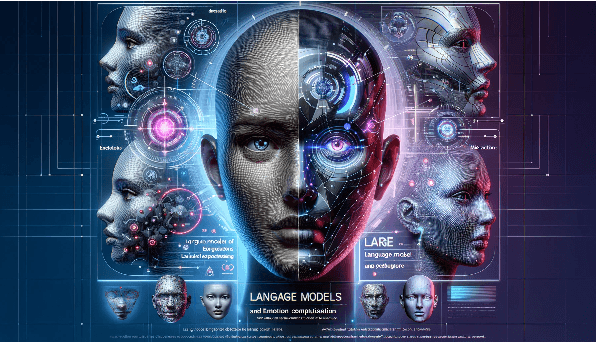

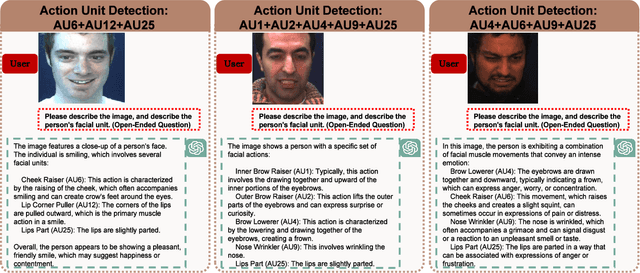
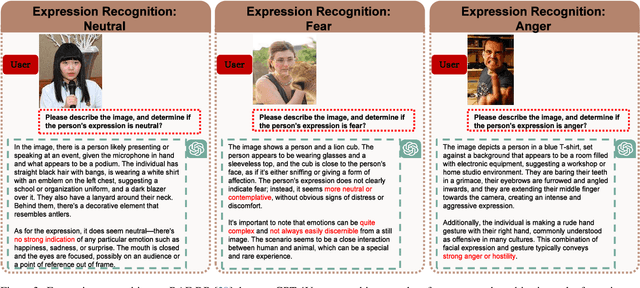
Abstract:Multimodal language models (MLMs) are designed to process and integrate information from multiple sources, such as text, speech, images, and videos. Despite its success in language understanding, it is critical to evaluate the performance of downstream tasks for better human-centric applications. This paper assesses the application of MLMs with 5 crucial abilities for affective computing, spanning from visual affective tasks and reasoning tasks. The results show that GPT4 has high accuracy in facial action unit recognition and micro-expression detection while its general facial expression recognition performance is not accurate. We also highlight the challenges of achieving fine-grained micro-expression recognition and the potential for further study and demonstrate the versatility and potential of GPT4 for handling advanced tasks in emotion recognition and related fields by integrating with task-related agents for more complex tasks, such as heart rate estimation through signal processing. In conclusion, this paper provides valuable insights into the potential applications and challenges of MLMs in human-centric computing. The interesting samples are available at \url{https://github.com/LuPaoPao/GPT4Affectivity}.
FedGT: Federated Node Classification with Scalable Graph Transformer
Jan 26, 2024



Abstract:Graphs are widely used to model relational data. As graphs are getting larger and larger in real-world scenarios, there is a trend to store and compute subgraphs in multiple local systems. For example, recently proposed \emph{subgraph federated learning} methods train Graph Neural Networks (GNNs) distributively on local subgraphs and aggregate GNN parameters with a central server. However, existing methods have the following limitations: (1) The links between local subgraphs are missing in subgraph federated learning. This could severely damage the performance of GNNs that follow message-passing paradigms to update node/edge features. (2) Most existing methods overlook the subgraph heterogeneity issue, brought by subgraphs being from different parts of the whole graph. To address the aforementioned challenges, we propose a scalable \textbf{Fed}erated \textbf{G}raph \textbf{T}ransformer (\textbf{FedGT}) in the paper. Firstly, we design a hybrid attention scheme to reduce the complexity of the Graph Transformer to linear while ensuring a global receptive field with theoretical bounds. Specifically, each node attends to the sampled local neighbors and a set of curated global nodes to learn both local and global information and be robust to missing links. The global nodes are dynamically updated during training with an online clustering algorithm to capture the data distribution of the corresponding local subgraph. Secondly, FedGT computes clients' similarity based on the aligned global nodes with optimal transport. The similarity is then used to perform weighted averaging for personalized aggregation, which well addresses the data heterogeneity problem. Moreover, local differential privacy is applied to further protect the privacy of clients. Finally, extensive experimental results on 6 datasets and 2 subgraph settings demonstrate the superiority of FedGT.
PVP: Pre-trained Visual Parameter-Efficient Tuning
Apr 26, 2023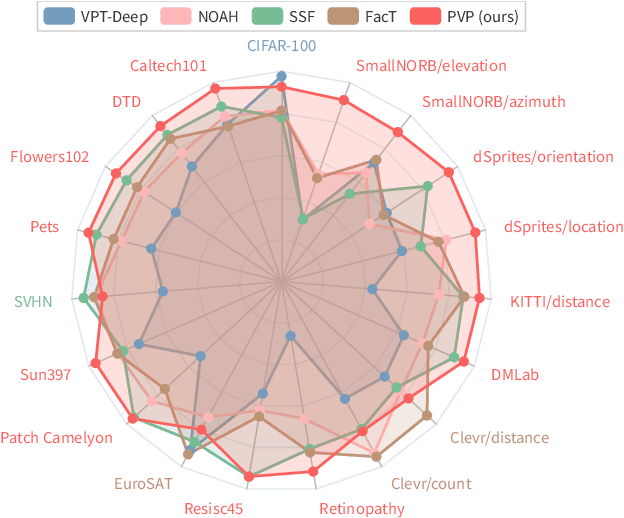
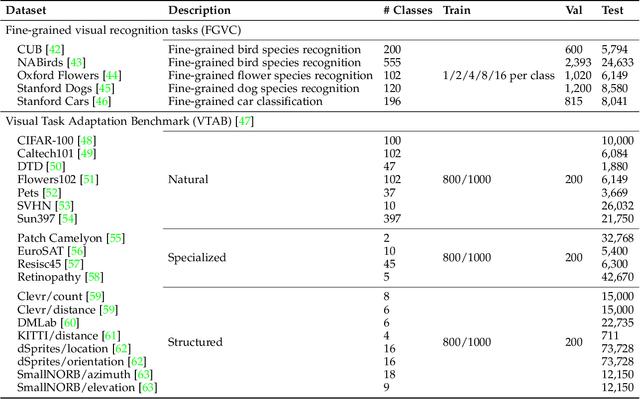
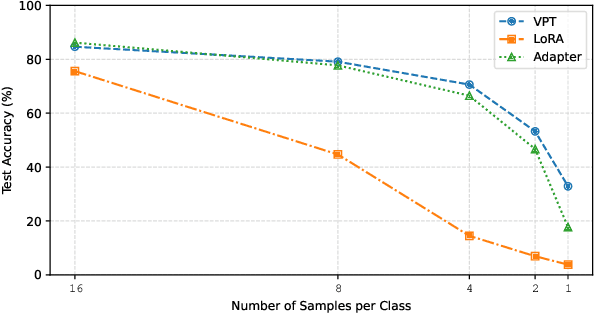
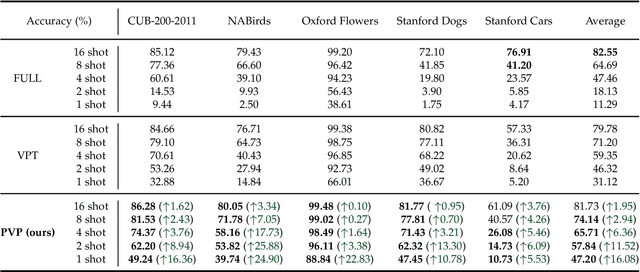
Abstract:Large-scale pre-trained transformers have demonstrated remarkable success in various computer vision tasks. However, it is still highly challenging to fully fine-tune these models for downstream tasks due to their high computational and storage costs. Recently, Parameter-Efficient Tuning (PETuning) techniques, e.g., Visual Prompt Tuning (VPT) and Low-Rank Adaptation (LoRA), have significantly reduced the computation and storage cost by inserting lightweight prompt modules into the pre-trained models and tuning these prompt modules with a small number of trainable parameters, while keeping the transformer backbone frozen. Although only a few parameters need to be adjusted, most PETuning methods still require a significant amount of downstream task training data to achieve good results. The performance is inadequate on low-data regimes, especially when there are only one or two examples per class. To this end, we first empirically identify the poor performance is mainly due to the inappropriate way of initializing prompt modules, which has also been verified in the pre-trained language models. Next, we propose a Pre-trained Visual Parameter-efficient (PVP) Tuning framework, which pre-trains the parameter-efficient tuning modules first and then leverages the pre-trained modules along with the pre-trained transformer backbone to perform parameter-efficient tuning on downstream tasks. Experiment results on five Fine-Grained Visual Classification (FGVC) and VTAB-1k datasets demonstrate that our proposed method significantly outperforms state-of-the-art PETuning methods.
Small but Mighty: Enhancing 3D Point Clouds Semantic Segmentation with U-Next Framework
Apr 03, 2023



Abstract:We study the problem of semantic segmentation of large-scale 3D point clouds. In recent years, significant research efforts have been directed toward local feature aggregation, improved loss functions and sampling strategies. While the fundamental framework of point cloud semantic segmentation has been largely overlooked, with most existing approaches rely on the U-Net architecture by default. In this paper, we propose U-Next, a small but mighty framework designed for point cloud semantic segmentation. The key to this framework is to learn multi-scale hierarchical representations from semantically similar feature maps. Specifically, we build our U-Next by stacking multiple U-Net $L^1$ codecs in a nested and densely arranged manner to minimize the semantic gap, while simultaneously fusing the feature maps across scales to effectively recover the fine-grained details. We also devised a multi-level deep supervision mechanism to further smooth gradient propagation and facilitate network optimization. Extensive experiments conducted on three large-scale benchmarks including S3DIS, Toronto3D, and SensatUrban demonstrate the superiority and the effectiveness of the proposed U-Next architecture. Our U-Next architecture shows consistent and visible performance improvements across different tasks and baseline models, indicating its great potential to serve as a general framework for future research.
Backdoor Defense via Deconfounded Representation Learning
Mar 13, 2023Abstract:Deep neural networks (DNNs) are recently shown to be vulnerable to backdoor attacks, where attackers embed hidden backdoors in the DNN model by injecting a few poisoned examples into the training dataset. While extensive efforts have been made to detect and remove backdoors from backdoored DNNs, it is still not clear whether a backdoor-free clean model can be directly obtained from poisoned datasets. In this paper, we first construct a causal graph to model the generation process of poisoned data and find that the backdoor attack acts as the confounder, which brings spurious associations between the input images and target labels, making the model predictions less reliable. Inspired by the causal understanding, we propose the Causality-inspired Backdoor Defense (CBD), to learn deconfounded representations for reliable classification. Specifically, a backdoored model is intentionally trained to capture the confounding effects. The other clean model dedicates to capturing the desired causal effects by minimizing the mutual information with the confounding representations from the backdoored model and employing a sample-wise re-weighting scheme. Extensive experiments on multiple benchmark datasets against 6 state-of-the-art attacks verify that our proposed defense method is effective in reducing backdoor threats while maintaining high accuracy in predicting benign samples. Further analysis shows that CBD can also resist potential adaptive attacks. The code is available at \url{https://github.com/zaixizhang/CBD}.
Hierarchical Graph Transformer with Adaptive Node Sampling
Oct 08, 2022



Abstract:The Transformer architecture has achieved remarkable success in a number of domains including natural language processing and computer vision. However, when it comes to graph-structured data, transformers have not achieved competitive performance, especially on large graphs. In this paper, we identify the main deficiencies of current graph transformers:(1) Existing node sampling strategies in Graph Transformers are agnostic to the graph characteristics and the training process. (2) Most sampling strategies only focus on local neighbors and neglect the long-range dependencies in the graph. We conduct experimental investigations on synthetic datasets to show that existing sampling strategies are sub-optimal. To tackle the aforementioned problems, we formulate the optimization strategies of node sampling in Graph Transformer as an adversary bandit problem, where the rewards are related to the attention weights and can vary in the training procedure. Meanwhile, we propose a hierarchical attention scheme with graph coarsening to capture the long-range interactions while reducing computational complexity. Finally, we conduct extensive experiments on real-world datasets to demonstrate the superiority of our method over existing graph transformers and popular GNNs.
 Add to Chrome
Add to Chrome Add to Firefox
Add to Firefox Add to Edge
Add to Edge